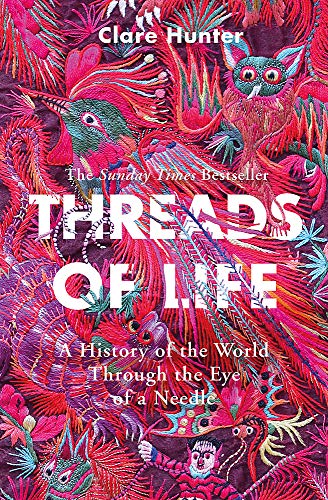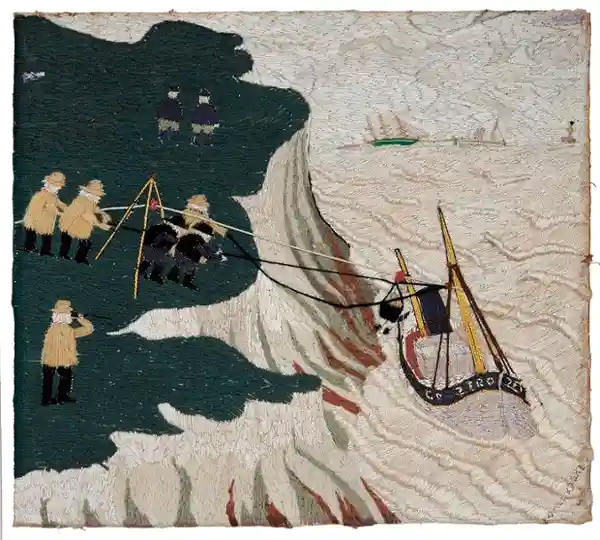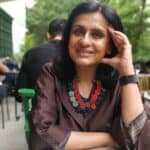24 Aug Threads of Life by Clare Hunter – A Book Review
Threads of Life, We’ve all grown up thinking of sewing and embroidery as women’s work: another unpaid and thankless chore. Darning socks, sewing on buttons, embroidering a child’s dress with a motif. But occasionally, we read something that gives us pause and allows us to look at our preconceived notions afresh. I was lucky to spot Threads of Life: A history of the world through the Eye of a Needle at my local bookstore.

Part history and part memoir, this book by Clare Hunter examines politics, memory, identity, and protest, but from the point of view of needlework. Clare Hunter is a textile curator and artist who has used her passion and knowledge to tell the story of men and women through history who have used the needle to express themselves in myriad ways. Sometimes in dangerous situations.
To tell this yarn, she examines the history of sewing under 16 heads. Some are Unknown, Power, Captivity, Identity, Journey, and so on. I’ll describe a few. To give the reader an idea of how she looks at things and the wealth of knowledge she imparts.
Please also check this video, which shows the book as the spark for the Autumn-Winter 2021-2022 Haute Couture collection by Maria Grazia Chiuri.
Unknown: Threads of Life
This chapter essentially looks at the history of the Bayeux Tapestry in France. It is not a tapestry at all but an embroidery! The Bayeux Tapestry tells the tale of The Battle of Hastings in 1066 and is a set of 58 scenes embroidered in wool yarn on coarse linen. It has always been called a tapestry because that somehow gave it more dignity in people’s minds since embroidery was considered women’s work.




Hunter points out that though so much has been written about this textile and its history, there is little or nothing about the actual sewers. The back-breaking work put in, the pressures, the almost certain awful working conditions, are ignored in the welter of history and social commentary. And this has been the fate of much work done by women.
Power: Threads of Life
This section looks at the tragic story of Mary Queen of Scots but concerning her wonderful embroidery. Imprisoned for long years, she used her skill with the needle to preserve her sanity. More than that, in an environment where she had no voice, she used embroidery motifs to communicate political messages, almost to tell her autobiography. In her hands, embroidery, a skill that even royals learned, became her message, the legacy she handed down




Frailty: Threads of Life
This is my favorite section. It talks of the therapeutic value of embroidery, how it helps the clinically depressed and the outright insane as a tool. In particular, I love the story of John Craske, an English fisherman who suffered from mental issues after World War 1. His wife taught him simple embroidery, which he then used to create innumerable scenes of the sea, and at the end of his life, The Evacuation of Dunkirk. Rediscovered only lately, we hope that his needlework gave him solace and comfort. I’m sure it did.


Protect: Threads of Life
In a strange coincidence or perhaps not strange at all, I recently wrote about Ainu textiles, believed by the Ainu to protect the body and the soul. I find that when you read something new, you often come across more about it, in a serendipitous twist. The Protect section describes the power of embroidery as a protective shield. Since evil could slide through openings, hems and necklines were protected with elaborate embroidery. Examples quoted are the folk art embroidery of Karnataka, where the chain stitch keeps out evil, and the Baawan Bagh of Punjab, with its dense 52 stitches.


I have a Chinese embroidered headdress for a child that I bought in Hong Kong. After reading this chapter, I wander into my drawing room and look at it afresh. The tiger embroidered into it was meant to protect the child wearing it. It was a functional sacred object.
Reading this book has shown me beyond all doubt that needlework is not simply the act of pulling the thread in and out of cloth. It is clear evidence of the history and culture of those who are gone. And particularly women, who have gone unrepresented in our chronicles and written history. Where there is scant textual evidence, the needlework can offer great insights. I strongly recommend that people interested in craft and culture read this excellent book.
Explore more fascinating information on Embroideries in our Embroidery Series
AUTHOR BIO
Mira Gupta is a well-known curator and designer in craft-based luxury. She has had working stints with Fabindia, Good Earth, and Ogaan to promote the cause of craft. She is deeply interested in art, travel, architecture, and culture.
Read more articles by the Author HERE






No Comments